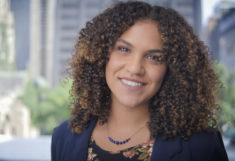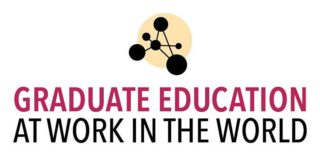Michelle May-Curry
Project director, Humanities for All, National Humanities Alliance
I entered the Graduate Education at Work conference wearing two hats. As a doctoral candidate completing a dissertation this summer in American Culture from the University of Michigan, I came excited to learn from my peers about the ways that they are utilizing their humanities research towards creating and joining opportunities for collaboration in their communities. My research is on visual culture, so my engagement with communities beyond academia has been predominantly through museums and gallery spaces. I have been lucky enough in doing this work to be supported by my home institution and by community organizations like The Carr Center, a visual and performing arts nonprofit serving Detroit’s Black arts community. This aid has come in the form of funding, physical space for collaboration, skill-building and, perhaps most impactful for my own professional life, room to imagine many career futures for myself.
In my role as project director of Humanities for All, meanwhile, I came ready to dream big about the possibilities for the publicly engaged humanities in higher ed and the infrastructure that might support it. Humanities for All, an initiative of the National Humanities Alliance Foundation, showcases the full range of higher-ed-based publicly engaged humanities initiatives, presenting a cross-section of over 1,800 undertaken over the past decade from all 50 states, the District of Columbia, and Puerto Rico. This collection includes humanities projects using community-engaged teaching, public programming, and research to connect with diverse publics as audiences and as partners.
As I am always working to surface new projects to highlight on our website, I was especially excited to attend the Grad at Work session “The Public Humanities: Expanding Graduate Educational Opportunities and Outcomes.” Session organizer Kristen Galvin created a space for participants to gather examples of publicly engaged initiatives and training programs being offered for graduate students in the humanities. These programs, what we at Humanities for All call the “infrastructure of engagement,” were diverse in their offerings, supporting everything from career diversity workshops to design studios, micro-grants for community events, and internships with local organizations. By the end of the session, the shared workspace was filled with examples, proving an invaluable resource for those looking to build similar programming on their campuses.
With only a few minutes remaining, however, Dr. Galvin asked us to join her in a blue sky brainstorming session.
Let’s indulge our imaginations! We have no issues in regards to budget, curricular restrictions, faculty buy-in, etc., that prevent the incorporation of public humanities-oriented projects/courses into graduate programs. What would such a graduate program look and feel like? How can we creatively reimagine graduate studies through public engagement and the support of public-facing projects?
The allure of blue-sky thinking, of course, is the suspension of reality––giving people the opportunity to see beyond omnipresent limitations such as pandemic-related departmental budget cuts, lack of administrative and/or faculty buy-in, and a strained academic job market for graduate students. Humanities scholars in area studies, African American studies, and queer theory are no strangers to this exercise in their research; the premise behind major theoretical ideas such as Afrofuturism and Queer Utopias requires seeing beyond the social inequalities of the present to construct different, more expansive futures for marginalized groups. Setting these constraints aside creates a space where creative innovation is playfully and optimistically encouraged, with big ideas begetting more precise, more immediately feasible ideas.
During our brief blue-sky session, participants came up with a number of desires for public humanities infrastructure: public-facing dissertation projects; coursework and workshops that include practical skills like budgeting, project management, and spreadsheet management; a retooling of university libraries as hubs of community engagement; having public humanities centers serve as consultants for departments interested in incorporating community engagement into their curriculum; and dedicated makerspaces or design studios for exhibitions and events. The general theme of these ideas suggests a hunger to rethink the “goal posts” of a secondary humanities degree and more directly train students for a range of career possibilities. They also suggest a desire to use the structures of the university to their fullest potential. Particularly at larger universities, students and faculty can feel siloed in their specific departments, even as hubs of engagement across campus (museums, libraries, and service learning centers) share a commitment to reaching a range of publics using humanities methods.
It is also striking that when asked to blue-sky brainstorm, participants came up with fairly pragmatic, achievable ideas. Across all small groups, the most repeated “blue-sky” desire was increased funding to create public-facing projects and programs that aim to train and practically support graduate students with skill acquisition and money throughout their graduate degree training. Historically, underfunded graduate students are often pushed to take practical, paid work with outside organizations, work that in effect helps orient them toward non-tenure career pathways and public humanities skillsets. If more graduate programs would recognize that work either for credit, as a building block for their academic requirements, or as a funding opportunity, then it might be less onerous and even more productive to engage in public-facing work.
That funding for the humanities was seen as a utopian ask, however, is itself an indicator of how entrenched the structural issues that plague commitments to humanistic knowledge production can be. The experience and perception of these challenges should not be imagined away as we imagine programmatic design and changes to campus infrastructures. This also extends to structures and challenges outside the university; keeping in sight the immediate and specific realities of the present––from municipal government agendas to language needs to public school values––helps establish how project directors and participants can ethically and effectively connect with the public around local histories and social issues. As we continue to think about the role of the publicly engaged humanities in graduate education, holding in tension the desire to think big for the future and to make an impact in the present is essential.


